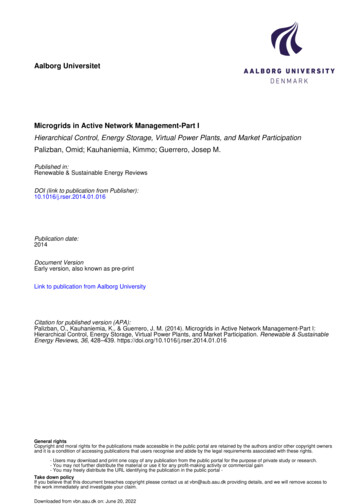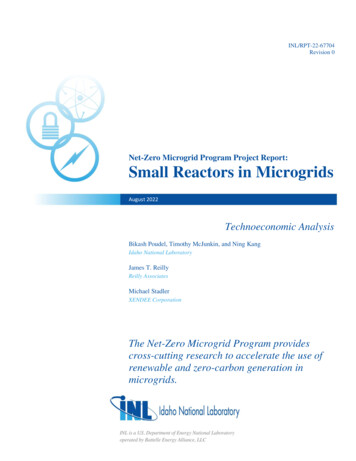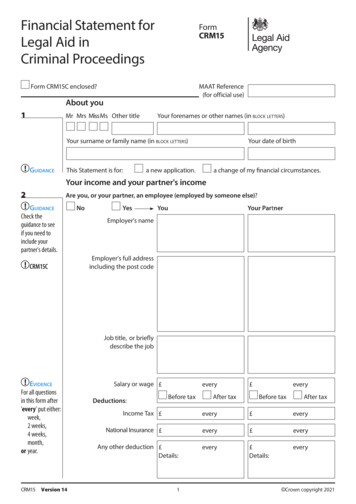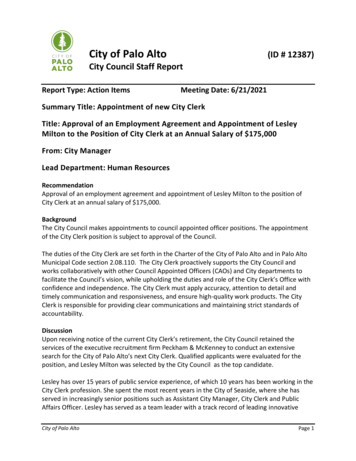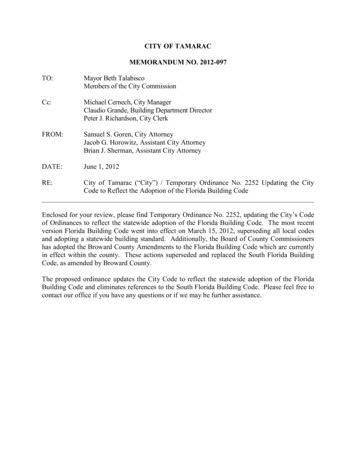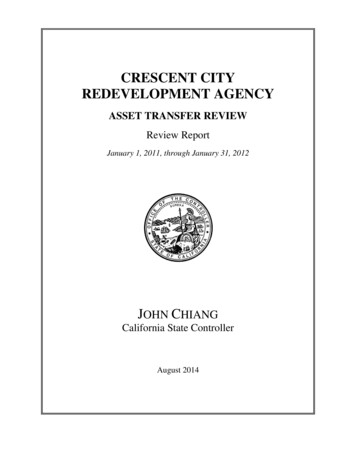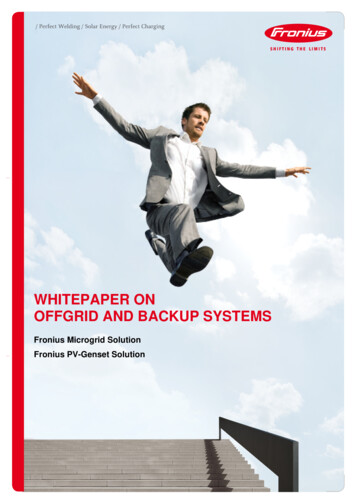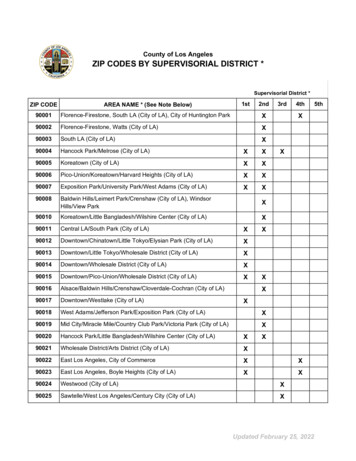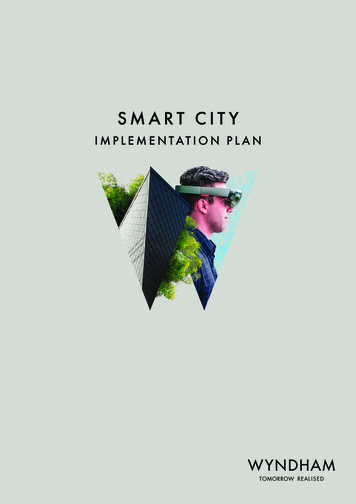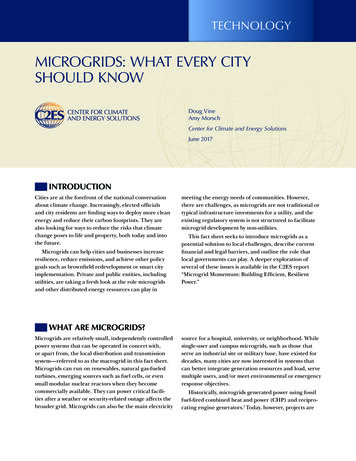
Transcription
TECHNOLOGYMICROGRIDS: WHAT EVERY CITYSHOULD KNOWDoug VineAmy MorschCenter for Climate and Energy SolutionsJune 2017INTRODUCTIONCities are at the forefront of the national conversationabout climate change. Increasingly, elected officialsand city residents are finding ways to deploy more cleanenergy and reduce their carbon footprints. They arealso looking for ways to reduce the risks that climatechange poses to life and property, both today and intothe future.Microgrids can help cities and businesses increaseresilience, reduce emissions, and achieve other policygoals such as brownfield redevelopment or smart cityimplementation. Private and public entities, includingutilities, are taking a fresh look at the role microgridsand other distributed energy resources can play inmeeting the energy needs of communities. However,there are challenges, as microgrids are not traditional ortypical infrastructure investments for a utility, and theexisting regulatory system is not structured to facilitatemicrogrid development by non-utilities.This fact sheet seeks to introduce microgrids as apotential solution to local challenges, describe currentfinancial and legal barriers, and outline the role thatlocal governments can play. A deeper exploration ofseveral of these issues is available in the C2ES report“Microgrid Momentum: Building Efficient, ResilientPower.”WHAT ARE MICROGRIDS?Microgrids are relatively small, independently controlledpower systems that can be operated in concert with,or apart from, the local distribution and transmissionsystem—referred to as the macrogrid in this fact sheet.Microgrids can run on renewables, natural gas-fueledturbines, emerging sources such as fuel cells, or evensmall modular nuclear reactors when they becomecommercially available. They can power critical facilities after a weather or security-related outage affects thebroader grid. Microgrids can also be the main electricitysource for a hospital, university, or neighborhood. Whilesingle-user and campus microgrids, such as those thatserve an industrial site or military base, have existed fordecades, many cities are now interested in systems thatcan better integrate generation resources and load, servemultiple users, and/or meet environmental or emergencyresponse objectives.Historically, microgrids generated power using fossilfuel-fired combined heat and power (CHP) and reciprocating engine generators.1 Today, however, projects are
FIGURE 1: An Example of a MicrogridElements of a microgrid could include: controllable generation like natural gas-fueled combined heat and power (CHP) and fuel cells;limited or non-controllable generation like a photovoltaic solar array or wind turbine (not shown); backup generators, uninterruptiblepower supply (UPS), and energy storage capability. Loads will vary significantly. The microgrid manager (at the center of the diagram)balances generation and load. The microgrid interacts with the macrogrid through the points of common coupling.Source: Siemens, “Microgrid Solutions” 2016. Available at: id/pages/microgrids.aspxincreasingly leveraging more sustainable resources likesolar power and energy storage.2crogrid might serve critical infrastructure such aspolice and fire stations, street lights, traffic lights,city water and wastewater facilities, and cell towers, to assure they can operate during blackouts.Community microgrids can also serve generalpurpose needs by providing power to displace orsupplement service from the macrogrid on a dayto-day basis.Several variations (and combinations) of microgridsare possible: 2Number of customers: Microgrids can serve asingle building, multiple customers in a limitedgeographic area, or customers across an entirecommunity. Microgrids commonly range insize from 100 kilowatts (kW) to mutiple megawatts (MW).Load types and functions: Microgrids can eitherserve load for ordinary commercial reasons, (a“general purpose microgrid”) or serve a community-oriented function, or both. A generalpurpose microgrid provides or supplements theservices customers might otherwise receive fromthe macrogrid. A “community microgrid” serves apublic purpose, such as aiding a community during an emergency. For example, a community mi-Center for Climate and Energy Solutions Connection type: An off-grid system does notconnect to the macrogrid and thus must be a sufficient power source for its customer. A microgridconnected to a macrogrid has greater flexibilitysince the macrogrid functions as an additionalresource.Microgrids currently provide only a tiny fraction ofU.S. electricity. In 2016, the United States had about 1.6gigawatts (GW) of installed microgrid capacity out of1,066 GW total capacity.3,4 Installed microgrid capacityis expected to increase to 4.3 GW by 2020. Most exist-
ing microgrid projects are concentrated in seven states:Alaska, California, Georgia, Maryland, New York, Oklahoma, and Texas.Notably, microgrids appear to be attractive to manylarge U.S. companies that are committed to workingon their own and in partnership with governmentsto transition to a sustainable low-carbon economy.NRG Energy, one of the country’s largest independentpower producers, has turned its Princeton, NewJersey headquarters into a fully-islandable microgriddemonstration project laboratory from which thecompany can test and refine ideas for real-worldapplications. NRG is also collaborating with gridoperator PJM to explore ways that microgrids can helpenhance macrogrid operations, findings that will be ofinterest to utilities across the country.5HOW WOULD A MICROGRID HELP MY CITY?Microgrids can provide several benefits to the environment, utility operators, and customers. These benefitsare particularly important to cities, which strive to createsafe, livable communities with thriving economies.Microgrids can reduce greenhouse gas emissions intwo ways:1.2.Offering the opportunity to deploy more zeroemission electricity sources. The microgridmanager (e.g. local energy management system)can balance generation from intermittentrenewable power sources such as solar withdistributed, controllable generation and storage(e.g., natural gas-fueled combustion turbines,thermal storage or emerging generation sourcessuch as fuel cells). They can also use energystorage to balance production and usage withinthe microgrid.Making use of energy that would otherwise belost. When power has to travel long distances(e.g. from a centralized power station), line lossesoccur, requiring additional generation to ensurethat far away demand is met. Since microgridelectricity is generated adjacent to where it will beused, line losses are minimized and less power isrequired to meet an equivalent level of demand.Additionally, when electricity is generated fromcertain centralized power sources (e.g., fossil fuelsand nuclear power) a great deal of heat energy iscreated, and typically released—unused—into theatmosphere. When power is generated close tothe end users, it becomes economically feasible touse this heat energy productively, such as heatingwater or space in nearby homes and businesses.Thus, less fuel is combusted overall, resulting inlower greenhouse gas emissions.When sited strategically within the electricitysystem, microgrids can help to lower electricity pricesand reduce peak power requirements by reducingor managing electricity demand and alleviating gridcongestion. In this manner, microgrids may supportsystem reliability, improve system efficiency, and helpdelay or avoid investment in new electric capacity.For example, New York City residents may benefit if aConEd demand management program, which includesa microgrid project in a low-income community, is ableto delay or defer building a 1.2 billion substation inBrooklyn or Queens.6,7In addition, microgrids can enhance grid resilienceto more extreme weather. When Hurricane Sandy cutoff power to millions of homes and businesses in theNortheast, a few areas—mostly parts of universities—kept the lights on using their own power generationsystems. Sustaining electricity service during widespreadnatural disasters is one reason for the growing interestin microgrids—particularly for city governments taskedwith maintaining critical public services. The city ofCharlotte, North Carolina, is exploring a public safetycampus microgrid powered by a solar PV system (anarrangement that combines climate change mitigationand resilience benefits). Microgrids such as this canalso help the macrogrid recover from a system outage,either indirectly, by sustaining services needed byrestoration crews, or directly, by helping to re-energizethe macrogrid.For cities on the edge of the macrogrid, microgridscan ensure power reliability. For example, in BorregoSprings, California, a mixed-ownership microgridis providing clean, reliable, and resilient power costeffectively to a hard-to-serve, isolated community.8Microgrids: What Every City Should Know3
BOX 1: Microgrids Provide Financial, Resilience, and Social BenefitsThe Food and Drug Administration (FDA) Federal Research Center microgrid in White Oak, Maryland, has an inherentresilience value: Money would be lost if scientific experiments were ruined due to loss of power and climate control. Whilesurrounding areas went dark during a 2011 earthquake, 2012 derecho event, Hurricanes Irene and Sandy, and numerousother storms, the FDA center’s microgrid remained online. The project prevents about 72,000 metric tons of carbondioxide equivalent emissions per year. It also provides ancillary services to the existing macrogrid, generating revenue forthe project.WHAT ROLE DOES LOCAL GOVERNMENT PLAY?Local governments can play a critical role in supportingmicrogrid technologies. Developers respond tomarket signals, and local policy can create clarity andcommunicate priority levels for microgrid developers.In addition, local governments can engage stakeholdersaround market needs and opportunities, and even set thetone as a microgrid customer. City leaders can considerthe following strategies.9,10Set the policy environment: Assist would-be developers in determining limitson their potential customer base, e.g. examinefranchise agreements that give exclusive rights tothe incumbent utility. Waive permitting fees and/or expedite thepermitting process. Grant zoning incentives to projects that includemicrogrid features such as energy storage,renewable generation or intelligent energymanagement. and renewable energy generation. Require or encourage developers to considermicrogrid technologies in permit applications.Support project development: Engage anchor institutions (like hospitals anduniversities) and developers on communityenergy use, public purposes and customers themicrogrids might serve. Identify locations ripe for economic development,or local energy systems that could be expanded. Provide information about undergroundinfrastructure to interested developers duringproject conception.Participate in and develop projects: Establish district energy zones that providemunicipal infrastructure that will allow futuremicrogrid development. Pursue projects as an anchor customer or supporting partner. Acting as a first mover and demonstrating intent can pave the way for attractingprivate sector participants.Ensure zoning codes and homeowners associationcovenants do not inhibit on-site energy storageWHO IS INVOLVED?Microgrid developers must work with the finance community, advisors, partners, customers, regulatory agencies, government officials, and other stakeholders. Developers/Owners: Builders or project managers of microgrids Investors: Financial backers of projects Advisors: Companies or individuals that providetechnical design support, and/or help prepareand communicate the financial case for the project to investors 4Partners: Companies that help to develop theCenter for Climate and Energy Solutionsproject including utilities or government entitiesin the case of a public-private partnership Customers: Consumers of the microgrid’s power,thermal energy, and other services Regulatory Agencies: Public utility commissionsand their like Government Officials: State and city officials Other Stakeholders: Community representativesand others who might be affected by the microgrid development
Cities are pursuing microgrids to ensure reliable power to critical infrastructure during grid outages. Portions of the city under microgridcontrol continue to function during a widespread outage.WHO OWNS AND PAYS FOR A MICROGRID?While each project is unique, here are three commonownership models: Utility-owned microgrids can often be fundedby including the capital cost in the utility’s ratebase, provided the utility can demonstrate theneed for and cost-effectiveness of the microgridto its regulators.11 These microgrids simply offera different technological approach to deliveryof traditional services by established serviceproviders. Privately-owned microgrids can be much morechallenging. They may compete with electricservice delivered through existing infrastructure,and face legal and administrative challenges thatlimit their deployment. Community-owned grids are often funded bygovernment sources (state and federal) throughbonds, tax credits, grants, loans, tax deductions,and credit enhancements. However, thesemicrogrids face financing challenges even instates that have encouraged such projects.12Long-term public-private ownership microgridsare gaining popularity because they allow for flexiblesharing of project risks and management. Mixedownership microgrid projects were nearly nonexistentin 2013, but were projected to make up 38 percent ofthe market in 2016. One example of this is in Maryland,where Schneider Electric, Duke Energy, and theMontgomery County government are collaborating ontwo microgrids to power county facilities. Ratepayerswon’t have to pay any extra costs, and the governmentwill get more resilient and affordable power withenvironmental benefits.13Developers seeking financing should first explore statefunding opportunities. In 2014, Massachusetts gave 18.4million to cities and towns for energy resilience projects,including microgrids.14 Connecticut has allotted 20million to microgrid projects, with most of the fundinggoing to municipal projects.15 California funded 27.3million for 10 microgrid and electric vehicle chargingprojects.16 States including California, Connecticut, andNew York have developed clean energy banks (CEBs orgreen banks), which leverage both public and privatedollars to fund clean energy, including some types ofmicrogrids.17DO MICROGRIDS MAKE FINANCIAL SENSE?A financial feasibility study can help quantify and reducemicrogrid development risk. This standard industrypractice includes calculating the project’s start-up costs,identifying the sources of funding, and calculating theMicrogrids: What Every City Should Know5
TABLE 1: Sources of Microgrid FinancePUBLIC FINANCE (FEDERAL, STATE AND MUNICIPAL)PRIVATE FINANCE Tax-exempt bonds Equity financing Tax credits Debt financing, loans Grants Corporate bonds Loans Tax deductionsEnergy saving performance contracts (ESPCs)—Energyservice companies (ESCOs) Credit enhancements Power purchase agreements (PPAs) Clean Energy Banks Third-party model Commercial property assessed clean energy (PACE) Resilience bonds Power purchase agreements (PPAs)project’s likely returns. Each project’s starting point islikely to be unique. Existing electrical infrastructureor generation assets can help mitigate the cost ofconstructing the system. Buying electric generationequipment typically accounts for the largest share ofthe development and construction cost.18 Other coststo consider are infrastructure build-out and microgridcontrol systems. Development and construction costs canescalate depending on the location of the microgrid,its degree of sophistication, and whether the project isdesigned to be scalable.19higher electricity price for a guaranteed uninterruptible power supply to keep valuable refrigerated and frozen food from perishing in the eventof a grid outage. A data center or other serviceprovider that cannot afford to be offline even foran instant might be willing to sign a contract for apremium service. Generating Renewable Energy Credits. A microgrid may be eligible to generate renewableenergy credits (RECs). While some owners willretire these RECs to assure their claim to “green”power, others may sell them, creating yet anotherrevenue stream. Selling excess power back to the larger grid. Providing macrogrid services. Participating indemand response markets or providing frequencyregulation services can provide another revenuestream.20Microgrids generate revenue in several ways: 6Providing metered electricity to consumerswithin the microgrid network. This provides asteady stream of income. Investors will considerthe basis on which these sales are made, includingthe duration of their commitment as well as thecreditworthiness of the customers. Providing metered thermal energy. A microgridcan provide hot water, steam, or chilled water –offerings most electric utilities do not provide. Ensuring reliable and resilient systems. Amicrogrid may attract a premium tariff fromcustomers that require a higher level of serviceand have a low tolerance for disruptions. Forexample, a grocery store may be willing to pay aCenter for Climate and Energy SolutionsThis revenue will be offset by operating costs,including fuel, labor, security, and administrativecosts, as any utility service provider will incur. Also,participation in markets to sell macrogrid services (e.g.,demand response, frequency regulation) has a cost,as the microgrid owner will need to become a marketparticipant or contract with a marketer able to makethe transactions. In addition, the microgrid owner may
need to purchase power from the macrogrid owner orthe wholesale market. Like any business, meeting suchobligations means the microgrid will have workingcapital requirements, which also need to be consideredwhen arranging financing.WHAT ARE THE LEGAL CONSIDERATIONS?Microgrid investors will be concerned with the legalenvironment in which the project will operate, andshould consider relevant statutes, regulations, marketrules, local ordinances, tariffed rates, terms and conditions (including interconnection rules and fees andstand-by power charges), and even electrical codes. Whilerisk related to future changes in law is unavoidable forany investment, the legal framework for microgrids isparticularly undeveloped and contributes to greater risk.This risk is based on an expectation that the legal voidwill be filled soon, although the contours of new laws areunknown.Microgrids confined to a single site and a singleowner, such as within an industrial complex or abuilding, are generally the easiest type of project toassess. No state prohibits an entity from self-supplyingits electrical needs, although the law may or may not behospitable to such arrangements and may limit the use ofleasing arrangements or other third-party services.Microgrids that serve multiple customers, however,face challenges from a legal framework that fails todefine the rights and obligations of the microgrid ownerwith respect to its customers and the macrogrid operator.In addition, state franchise rights and rights-of-way lawsgranted to utilities may limit microgrid developers’access to customers. Connecticut was the first state todevelop a legal definition of a microgrid to promotecommunity microgrids for resilience in the wake ofHurricane Sandy.21 However, the Connecticut law isnot designed to provide a complete framework for thedevelopment, connection, and integration of microgrids,including those that serve other purposes. Other statesare even further behind in providing legal certainty.Addressing these legal barriers is essential to the widerdeployment of microgrids.CONCLUSIONMicrogrids can deliver benefits to the environment,the power system, and energy customers by enablingdeployment of greater quantities of low-emission energysources, creating opportunities for greater efficiencies,and ensuring system reliability. These benefits will be feltby the customers and their surrounding communities,which is a major reason microgrids are being consideredacross the United States. Although there is growinginterest in related “smart city” investments, renewableenergy, and resilience measures, greater awareness isneeded about microgrids’ potential and how they fit intothe electricity grid of the future. Local governments cansupport increased awareness and decision-making byfirst understanding the variety of microgrid types andownership models discussed here, as well as the emerging policy needs associated with microgrid technologies.While project developers and partners must navigatelegal uncertainties and establish financing plans, municipalities have the unique capability to support thetechnology by creating development incentives, removingpolicy hurdles, and even pursuing their own microgridprojects.Microgrids: What Every City Should Know7
ENDNOTES1 Wood, Elisa, “US Microgrid Market Growing Faster than Previously Thought: New GTM Research.” GreentechMedia. August 29, 2016. -gtm.2Ibid.3 Wood, Elisa, “US Microgrid Market Growing Faster than Previously Thought: New GTM Research.” GreentechMedia. August 2016. -gtm.4 U.S. Energy Information Administration, “Electric Power Monthly: Table 6.2A.” Accessed on July 5, x.cfm.5NRG, “Sustainable Headquarters.” Accessed on May 8, 2017. 6 Bade, Gavin, “ConEd Brooklyn-Queens non-wire alternative project installs first microgrid.” December 14, st-microgrid/432380.7 Tweed, Katherine, “Con Edison Unveils Auction Numbers for Its Pioneering Demand Management Program inNew York.” Greentech Media. August 5, 2016. ram.8 Anderson, Erik, “Microgrids power desert community and urban campus.” Inside Energy. December 21, -power-desert-community-and-urban-campus.9 Bourgeois, Thomas, et al., “Community Microgrids: Smarter, Cleaner, Greener.” Pace Energy and Climate Center. Accessed on April 26, 2017. ogrids-smarter-cleaner-greener.10 Pace Energy and Climate Center. “Microgrids & District Energy: Pathways to Sustainable Urban Development.”Accessed on April 26, 2017. .11See, infra, discussion at n. 51.12 Wood, Elisa, “Connecticut Figures Out Microgrids (And Helps the Rest of Us) Part 2.” April 7, 2015. out-microgrids-and-helps-the-rest-of-us.13 Spector, Julian, “Microgrids on the March: Utilities Are Building Out New Business Models to Make IslandingWork.” Greentech Media, February 7, 2017. ibutech-roundup-microgrids-on-the-march.14 Wood, Elisa, “Massachusetts Awards 18.4M for Microgrids and other Energy Resiliency Projects.” MicrogridKnowledge, Dec. 29, 2014. -18-4m-microgrids-energy-resiliencyprojects.15 Wood, Elisa, “Connecticut Figures Out Microgrids (And Helps the Rest of Us) Part 2.” Microgrid Knowledge,April 7, 2015. out-microgrids-and-helps-the-rest-of-us.16 Wood, Elisa, “California Awards 27.3M for Microgrids and EV Charging Projects.” Microgrid Knowledge, Feb. 4,2015. -3m-microgrids-ev-charging-projects.17 Wood, Elisa, “Green Banks to Finance Microgrids?” Microgrid Knowledge (Nov. 2, 2015). ce-microgrids.18 Wood, Elisa, “What Does a Microgrid Cost?” Microgrid Knowledge, April 26, 2016. ter for Climate and Energy Solutions
19 Wood, Elisa, “What Does a Microgrid Cost?” Microgrid Knowledge, April 26, 2016. https://microgridknowledge.com/microgrid-cost.20 National Electrical Manufacturers Association, “Microgrids, Macro-Benefits: How to talk to decision makersabout building your own electric power system.” 2014. ogridsMacro-Benefits.pdf.21 As defined by Connecticut, “’[m]icrogrid’ means a group of interconnected loads and distributed energy resources within clearly defined electrical boundaries that acts as a single controllable entity with respect to the grid and thatconnects and disconnects from such grid to enable it to operate in both grid-connected or island mode.” Conn. Gen. Stat.§16-243y.The Center for Climate and Energy Solutions (C2ES) is an independent, nonpartisan, nonprofit organization working to forgepractical solutions to climate change. Our mission is to advance strong policy and action to reduce greenhouse gas emissions,promote clean energy, and strengthen resilience to climate impacts.2101 WILSON BLVD. SUITE 550 ARLINGTON, VA 22201 703-516-4146C2ES.ORGMicrogrids: What Every City Should Know9
delay or avoid investment in new electric capacity. For example, New York City residents may benefit if a ConEd demand management program, which includes a microgrid project in a low-income community, is able to delay or defer building a 1.2 billion substation in Brooklyn or Queens.6,7 In addition, microgrids can enhance grid resilience
